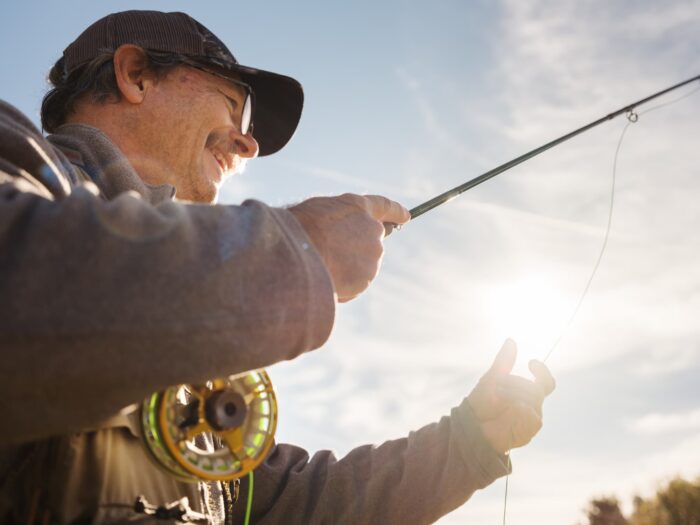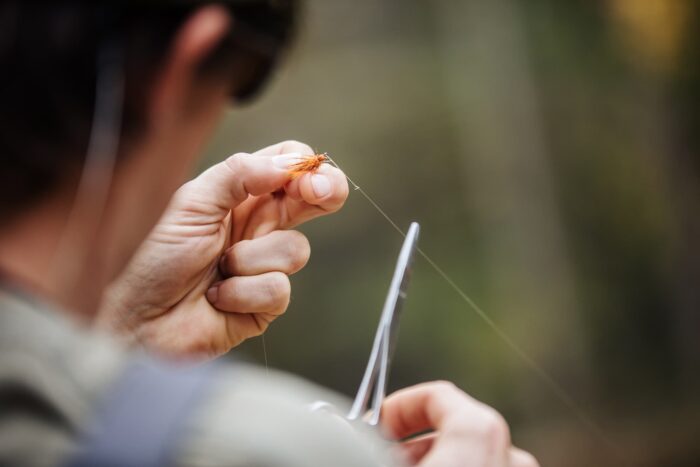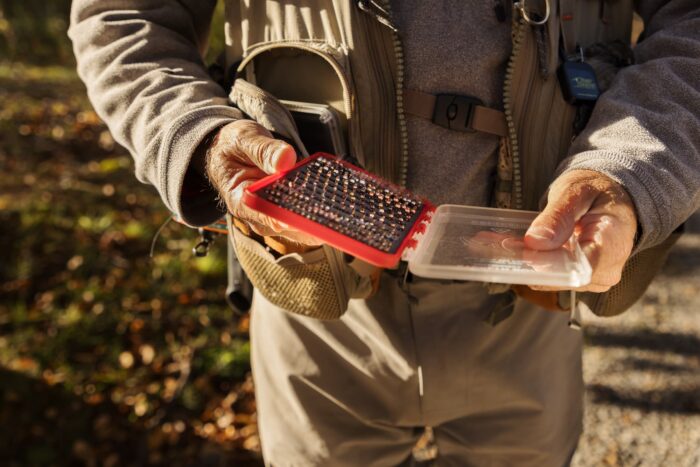Top Spring Fishing Spots in Pocahontas County, WV
Spring brings a fresh wave of excitement, and what better way to celebrate than by casting a line in some of the most beautiful waters in the country? Pocahontas County, West Virginia, is a haven for anglers, offering a diverse range of fishing opportunities, particularly for trout.
The West Virginia Gold Rush, a renowned program by the West Virginia Division of Natural Resources (WVDNR), lures in anglers with over 50,000 golden rainbow trout stocked across various lakes and streams throughout the state, including Pocahontas County. These vibrant fish are a prized catch, adding an extra thrill to your fishing experience. But that’s not all – our county boasts healthy populations of brown, brook and rainbow trout, making it a true trout fisherman’s paradise.
Here is a guide to the top spots to cast your line in Pocahontas County this spring.

Must-Try Spring Fishing Spots
WV Gold Rush Week One (April 1-6)
- Buffalo Fork Lake
Cast a line at Buffalo Fork Lake, a serene 22-acre impoundment located within the Monongahela National Forest. This hidden gem offers exceptional spring trout fishing, with stockings throughout the season (February, bi-weekly March-May and twice in October). Even outside peak season, there’s a good chance you’ll encounter some holdover trout. For variety, target the lake’s small warm-water fishery, teeming with smallmouth bass, bluegill, green sunfish and channel catfish. The serene atmosphere makes this lake ideal for a peaceful paddle and a relaxing day of fishing. - Cranberry River
Renowned as one of America’s premier trout streams, the Cranberry River is a must-visit for serious anglers. This scenic waterway offers various sections, including stocked areas containing more trout per acre than any waterway in the state and a designated fly-fishing-only zone. The South Fork, accessible by foot, is stocked from February to May, while the lower section downstream offers opportunities throughout the year. - Greenbrier River (At Durbin)
While many sections of the Greenbrier River are known for smallmouth bass fishing, Pocahontas County offers the prime spot for spring trout catches on the East Fork. This section is regularly stocked from January to May, making it a great choice for seasonal fishing adventures. The Upper Greenbrier River provides multiple access points, perfect for both wading and float fishing. - Seneca Lake (Seneca State Forest)
Craving a quieter catch? Head to Seneca Lake, a four-acre gem nestled within the vast (nearly 12,000 acres) Seneca State Forest. The lake is stocked once in February and once every two weeks in March, April and May, then twice during the fall. Surrounded by rolling, forested hills that meet the water’s edge, this lake offers a charming sense of seclusion. While a boat launch isn’t available, electric motors are welcome on small boats – perfect for quietly navigating the lake’s perimeter in search of trophy trout. - Watoga Lake (Watoga State Park)
If your idea of fishing is less about being in the water and more about enjoying a scenic float on calm waters, Watoga Lake might be the best spot. The 11-acre lake is tucked away in the mountainous landscape of Watoga State Park. Stocked by the WVDNR, Watoga Lake produces trout well into the fall and winter months. This calm lake is ideal for families introducing youngsters to the joy of fishing with healthy populations of trout, largemouth bass, bluegill and sunfish. - Williams River
The Williams River, a breathtaking 30-mile stretch of wilderness waterway, winds its way from Black Mountain to its confluence with the Gauley River. Acquiring 27,000 pounds of trout annually, the Williams River receives weekly stockings from March to May. This plentiful fishery stretches for 22 miles downstream from Day Run Campground, all the way to the Laurel Run coal tipple. For a quick fishing trip, target the middle section, easily reached via the Highland Scenic Highway. For extended adventures, take the Williams River Road (Forest Road 86 and 216), which follows the river and offers rustic campsites, many situated right next to the water. The river’s remarkable pools and abundant in-stream cover provide endless opportunities to test your casting skills.

WV Gold Rush Week Two (April 7-13)
- Elk River
Often hailed as the state’s best trout fishery, the Elk River stretches over 21 miles and caters to anglers of all skill levels. Easy access for wading and shore fishing, along with regular stocking schedules, make the Elk a favorite among fishermen. The headwaters of the Elk are formed by the confluence of Big Spring Fork and Old Field Fork in the Slaty Fork community. For the first 4.6 miles, it flows through the virtually untouched Monongahela National Forest. After emerging from the wilderness, it becomes known as the Lower Elk or Elk Springs section. Despite its designation as a medium-sized stream, the Slaty Fork Elk boasts deep pools that challenge anglers. The healthy population of both rainbow and brown trout, some exceeding 20 inches, thrives thanks to the limestone bedrock that nourishes an abundance of aquatic insects, providing a plentiful food source for these prized fish. - Greenbrier River (At Cass)
Head to Cass and cast a line in the Greenbrier River during the second week of the WV Gold Rush for prime fishing conditions. Wade in from the Greenbrier River Trail for some easy exploration, or plan a longer float trip with put-in and take-out options at the Marlinton Bridge (near the swings), Blue Bridge (Buckeye), Seebert Bridge or Beard. - Shavers Fork
The Shavers Fork of the Cheat River offers some of West Virginia’s best year-round trout fishing, thanks to its high elevation, cool temperatures and consistent stocking program. Twice a year, in spring (January-May) and fall (October), the WVDNR supplements the healthy natural trout population with rainbow, golden rainbow, brown and brook trout. This regular stocking ensures anglers have a good chance of catching a fish, even during slower periods. The Upper Shavers Fork, found in the heart of West Virginia’s red spruce forests, boasts a thriving wild trout population. For fly fishing enthusiasts, the Lower Shavers Fork offers a dedicated catch-and-release section. This peaceful area is a favorite for practicing techniques while preserving the fishery. Be prepared to wade in the river, and some light hiking may be required to reach less-frequented stretches.
Beyond the Big Names
Pocahontas County offers a variety of hidden gems for those seeking a more secluded fishing experience. Here are a few worth exploring:
- Knapp Creek
This tributary of the Greenbrier River is a delight for anglers. The WVDNR regularly stocks the section between Minnehaha Springs and Marlinton, offering eight miles of fishable water. And for your convenience, the stocked section runs right next to West Virginia Route 39, with easy access points along the way. - Deer Creek
Located near Cass, Deer Creek provides a more rustic fishing experience. This one-and-a-half-mile stretch is stocked monthly from February to May and requires some walking to access. - Hills Creek
Perfect for those seeking adventure, Hills Creek is another excellent option. This stream is stocked from February to May and offers three miles of fishable water upstream from the first bridge at Lobelia.

Gear Up for Your Pocahontas County Fishing Adventure
Before casting your line, make sure you have the essentials. All anglers 15 years and older need a valid West Virginia fishing license and trout stamp, conveniently obtainable online. Don’t forget a reliable fishing rod, reel and tackle suited for your target catch. Waders will open up access to deeper waters and prime fishing spots while packing water, food, maps and a GPS is crucial (cell service can be limited in some areas).
With its diverse fishing opportunities, breathtaking scenery and the promise of landing a prized golden trout during the West Virginia Gold Rush, Pocahontas County guarantees an unforgettable spring fishing adventure. Grab your gear, obtain your license and get ready to experience the thrill of fishing in Nature’s Mountain Playground! To help you plan your trip, request a copy of our free Sportsman Map and Information Brochure. This handy pocket-sized guide is packed with valuable information like access points to Wildlife Management Areas, campgrounds, outfitters and stream stocking details – making it your one-stop trip planning resource.
